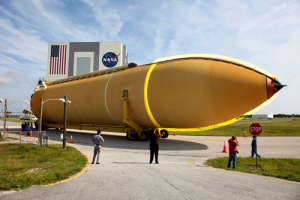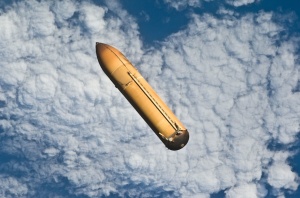In a previous post on launch and reentry, I referenced Reaction Engines and their revolutionary SABRE (Synergistic Air-Breathing Rocket Engine) technology. This engine represents the closest we’ve come to developing true reusable space access. This week, it got a little closer. British aerospace mammoth, BAE Systems, invested $31.8M into Reaction Engines for a 20% stake in the company. That such a large company would make such an investment, speaks volumes about the viability of what Reaction Engines has accomplished – and plans to accomplish with its revolutionary space plane design: Skylon.
Why is their technology so revolutionary?
 First, let’s talk about what it takes to get to orbit. Primarily it’s energy, energy in the form of thrust. The thrust comes from burning fuel. Sound simple? It is actually. Since the earliest days of rocketry this basic principle has shot countless items into the sky and space. However, to burn fuel, you need to have oxygen, and this is where one of the primary problems comes into play. In all orbital craft to date, oxygen has been carried along with the fuel for the rockets and engines. For the Space Shuttle, it was carried in the forward section of the massive external tank. The image to the left outlines the portion of the tank utilized for liquid oxygen. While it is smaller in size to the hydrogen tank behind it, remember that oxygen is about sixteen times heavier than hydrogen. That “smaller” area carries up to 143,351 gallons at a weight of 1,361,936 pounds! By contrast, the liquid hydrogen tank carries 385,265 gallons and weighs in at a svelte 227,641 pounds. Considering the Space Shuttle weighed in at only 243,200 pounds (empty, including tank), you can see that the oxygen represents the lion’s share of the weight required to take a spacecraft to orbit.
First, let’s talk about what it takes to get to orbit. Primarily it’s energy, energy in the form of thrust. The thrust comes from burning fuel. Sound simple? It is actually. Since the earliest days of rocketry this basic principle has shot countless items into the sky and space. However, to burn fuel, you need to have oxygen, and this is where one of the primary problems comes into play. In all orbital craft to date, oxygen has been carried along with the fuel for the rockets and engines. For the Space Shuttle, it was carried in the forward section of the massive external tank. The image to the left outlines the portion of the tank utilized for liquid oxygen. While it is smaller in size to the hydrogen tank behind it, remember that oxygen is about sixteen times heavier than hydrogen. That “smaller” area carries up to 143,351 gallons at a weight of 1,361,936 pounds! By contrast, the liquid hydrogen tank carries 385,265 gallons and weighs in at a svelte 227,641 pounds. Considering the Space Shuttle weighed in at only 243,200 pounds (empty, including tank), you can see that the oxygen represents the lion’s share of the weight required to take a spacecraft to orbit.
What if most of that oxygen went away? Or, more appropriately, what if it came from somewhere else like the atmosphere? There are a couple problems with this. First, the atmosphere essentially stops before you get into orbit. So you can’t take an air breathing engine all the way up. That’s a fairly easy solve. Reaction Engines does it by using air for oxygen to go as high as possible, then begins to switch over to an internal tank of liquid oxygen to take the final step.
The second problem is far more complex: heat. The same air that allows you to save all that weight by pulling it in from outside, also generates a lot of heat when a spacecraft goes through it to reach the speeds necessary to take it to orbit. What’s the problem? It can’t be nearly the heat of reentry, can it? The issue doesn’t have to do with protecting the spacecraft, the issue has to do with the temperature of the air entering the engine. On the Skylon spacecraft pictured at the top of the story, that temperature is more than 1,800 degrees F (1,000 C) .
Reaction Engines’ secret sauce is that they’ve come up with a super cooler to dramatically lower the temperature of the incoming air so the engines can operate efficiently. This allows Skylon to take off like a plane, using outside air to burn fuel, and get to very high speeds while still in the atmosphere, lessening the internal fuel/oxygen burden to get to the speed necessary take it to orbit.
Today, all spacecraft launch vertically. This requires a lot of thrust to overcome Earth’s gravity and carry the launch vehicle to escape velocity. That much thrust requires a lot of what is called “specific impulse.” In short, that represents how efficient an engine is for how much fuel it burns. Like a muscle car burns a lot of fuel so it can accelerate quickly, rockets burn a ton of fuel to take off vertically. But take that muscle car and turn it into a Prius. It takes 9.5 seconds to get from 0-60, but it also gets north of 50 mpg vs. a Dodge Charger’s 16. By taking off like a plane and using the lift provided by the atmosphere, Skylon gets to orbit more like a Prius and less like a Charger. This allows it to use (and thus carry) less fuel.
 By only carrying the lower amount fuel (and a little bit of oxygen) internally, Skylon avoids having to carry, and later discard, a massive external tank like the Space Shuttle used. All of this points to a much lower cost to operate. By Reaction’s estimate, the cost per pound of payload will be an order of magnitude (roughly 10x) cheaper than current methods of launching things into space.
By only carrying the lower amount fuel (and a little bit of oxygen) internally, Skylon avoids having to carry, and later discard, a massive external tank like the Space Shuttle used. All of this points to a much lower cost to operate. By Reaction’s estimate, the cost per pound of payload will be an order of magnitude (roughly 10x) cheaper than current methods of launching things into space.
Reaction estimates that an unmanned, fully reusable launch vehicle can be in operation in 10-15 years and a passenger vehicle within two decades. Hopefully both the investment and partnership of BAE can speed that along.
Photo credits: Reaction Engines, NASA (Space Shuttle images) and United Launch Alliance (Atlas rocket)


[…] it’s with a space elevator or reusable space craft, one thing seems certain: the cost of getting to space will be dropping dramatically in the […]